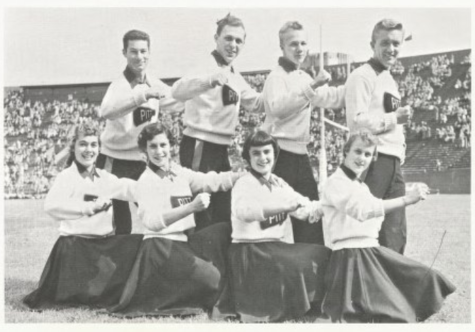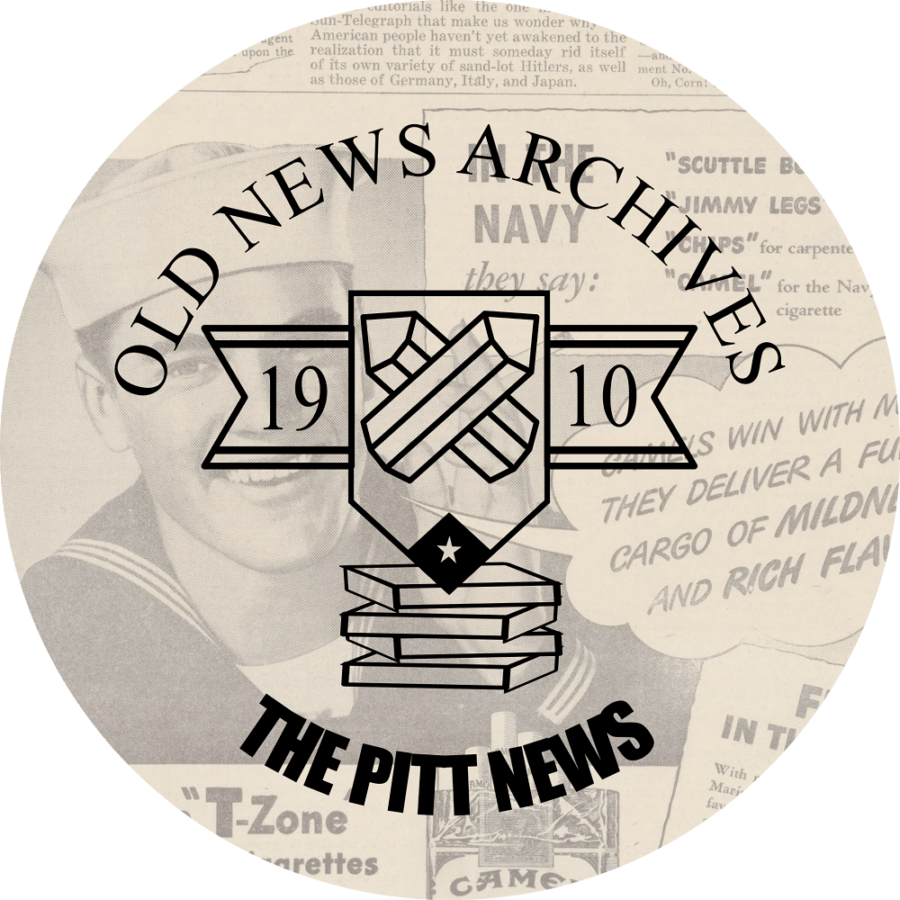Old News: Pitt women break into cheerleading
Old News is a bi-weekly blog dragging up ancient Pitt history. Here, we’ll retell some of the weird, interesting or relevant stories we find in The Pitt News’s archives at Documenting Pitt.
More stories from Emily Wolfe
Pitt’s 1954 Homecoming game was a historic one.
The size of the crowd wasn’t record-breaking — 28,000 people attended, respectable for Pitt Stadium — and the team didn’t have a hard time beating its opponent, Northwestern University, by a modest 14-7.
The historic part was on the sidelines, where for the first time at a Pitt Homecoming game, four female cheerleaders yelled and jumped in school spirit alongside four of their male classmates. Or as the University’s 1955 yearbook put it, “for the first time in Pitt’s one hundred and sixty-eight years, the provocative forms of women cheerleaders joined the male line of excited pep-rousers.”
Today, Pitt’s cheerleading team, like the sport in general, is largely female. But when cheerleading squads first appeared in the late 19th century, they looked very different. Groups of young men calling themselves “yell teams” started to pop up at Ivy League college football games, shouting encouragement at their teams and rousing the student sections.
Soon enough, they got uniforms and started calling themselves “cheerleaders.” These cheerleaders weren’t waving pom-poms, although they ran through a series of practiced chants. One Pitt News columnist, Dave Green, grouched that the cheerleaders and their “school spirit” were overrated and annoying.
“To condemn the average Pittite because he doesn’t shout his lungs out at a pep rally is downright unfair,” Green wrote in 1953. “The academic type who brings honor to his school through research probably has as much love for old Skyscraper U. as does the gravel-throated cheerleader.”
During the 1940s, as young male college students started leaving school to fight in World War II, women across the country entered cheerleading squads. But not Pitt’s. The Panthers’ cheerleading squad stayed exclusively male into the 1950s, though the exclusivity became a hot topic of debate.
“We haven’t the slightest doubt that our present crop of all-male cheerleaders are very nice fellows, and that they have the best interests of the school at heart, but why all males?” wrote the W.W.W.C Committee — We Want Women Cheerleaders, a group composed of three male students and one female — in a 1950 letter.
When The Pitt News polled its readers on the issue, responses varied, and the sides weren’t divided along gender lines.
“When you see a pretty girl out there, you can’t help but get excited,” Bruce Stoehr, an engineering student in favor of female cheerleaders, told the paper. Gloria Heneghan disagreed, saying, “It’s not a good idea; boys have more pep. When it rains, the girls look like drowned rats.”
Pitt’s Student Congress put the matter to a student referendum vote in February 1954. More than 3,500 students voted, and most were in favor of allowing women to join the cheerleaders — 83% of women voted for the proposal, and 94% of men.
The measure still needed to be approved by certain University authorities and by the University’s Women’s Self-Government Association, which initially rejected it out of concerns that, among other things, “women would lose their femininity as cheerleaders.” At last, however, all relevant parties agreed, and the cheerleading team’s official guidance became “to consist of all of the most capable persons whether female or male or a combination thereof.”
The first coed cheerleading team contained equal parts men and women. In the 1955 yearbook, they lined up by gender — kneeling in the first row are Ginny Anthony, Thelma Ackerman, Pauline Markess and Dorothy Tear, and in the second row, Herb Rebhun, Al Katz, Ron Rathaus and captain Chet Zukowski.

Zukowski told The Pitt News the female cheerleaders he worked with were “great.”
“There has been beautiful cooperation this year,” Zukowski said. “They are working hard because the pressure is on and they know they have to make good.”
Emily Wolfe is the digital manager at The Pitt News. An Ashburn, Virginia native, Emily plans to graduate in 2022 with majors in fiction writing, French...







